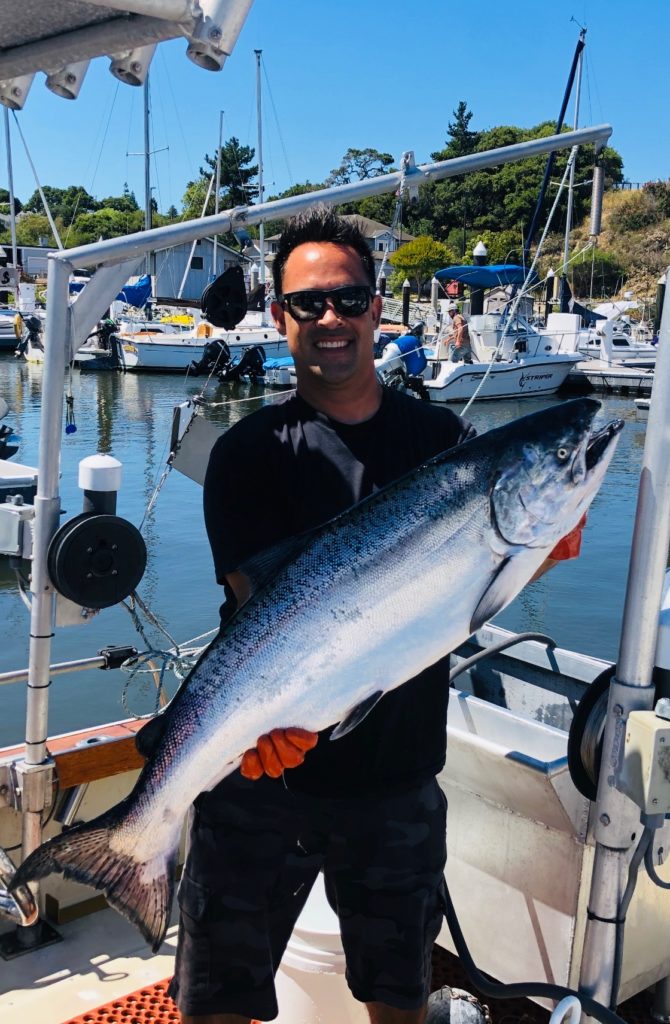Local wild king salmon season just opened and this past weekend our local salmon fisherman Jason Chin dropped off our first batch of Chinook (King) salmon. We have been working with Jason for over 10 years now and are always thoroughly impressed with the quality and condition of the fish that he brings in. His salmon has a bright orange succulent flesh that looks so flawless that you must see it to believe it. Jason’s wild Chinook salmon is truly one of the best. While he was here he was kind enough to share some insider knowledge about the industry.
1. What methods of fishing do you use when catching wild salmon?
Jason Chin: For all the wild king salmon that I catch I use the trolling method with a hook and line, handling one fish at a time. This method entails one line clipped to the back of my boat which is then pulled at a speed of about 3-4 knots. I use bait such as anchovies and other small fish or a metal or plastic spoon to attract the fish. If I happen to catch any bycatch, I can simply unhook it from my line and throw it back into the water.
2. On a good day about how much fish would you bring in?
Jason Chin: I have a small independently owned 20-foot boat and I only go on day trips. This differs from the larger fleets that can spend several nights out on the water. Depending on the day, I hope to bring in about 30 salmon. I catch and process each salmon myself and I think that adds to the quality.
3. What effects the quality of the fish?
Jason Chin: There are many variables that affect the quality of the fish. I think the biggest factor is the care you put into the fish. I try to go the extra mile in every step of the fishing process. It is small things that make the fish I supply standout compared to some of the other guys. For example, many people use nets to help bring the fish aboard, but I find that can negatively affect the quality of the fish, so I tend to pull the fish up by hand. This is because when the fish are thrashing around in the net which can cause minor injuries to the salmon. Once I get the fish onto the boat, I immediately bleed the fish which kills the fish. I use a method called pressure bleeding after the initial bleed which drains out any remaining blood. This method pushes all the blood out of the ribs near the belly which allows the salmon’s belly to maintain a firm texture ultimately extending the shelf life and improving the taste. Finally, once I gill and gut the salmon they go straight into slush (a mixture of saltwater and ice). Chilling the salmon immediately after harvest allows for the fish to remain as fresh as possible. Additionally, because I only go on day trips, I drop off the fish to Royal Hawaiian or other purchasers within the same day it was caught. This ensures maximum freshness.
4. What are the main locations you tend to fish in?
Jason Chin: I fish south of Pigeon Point near Santa Cruz. The season in Monterey begins May 1st and ends in mid-August.
5. What are the biggest problems that you see within the salmon fishing industry?
Jason Chin: There are many answers to this question but two of the biggest problems I see within the California salmon fishing industry are fishery management and water management. The California state government sets fishing quotas every year which limits the number of fish we are allowed to catch. The quota is based on forecasting formulas made by state fishery management which predict the number of salmon returning to the rivers. This is a hard number to accurately capture and often the formulas are wrong which can negatively affect my ability to bring in salmon. The second problem is water management, which of course affects many industries in California. As all of us Californians know, water is a scare resource which is highly sought after by many people. Regulating the flow of water in the rivers is a huge problem in the wild salmon fishing industry. Either there is not enough water in the streams so that the salmon cannot spawn, or alternatively, when there is too much water it washes out all the newly spawned fish. To help supplement the smolt (baby salmon) population, hatcheries have begun raising salmon eggs and releasing them into the water. This has helped the population immensely. Most wild salmon that are caught these days are born and raised in hatcheries for the first several months of their lives.
6. What made you want to become a fisherman?
Jason Chin: I start fishing very young and have always enjoyed it. You must have a passion for fishing, and anyone that tells you they are doing it for the money is lying. Having a good relationship with a buyer is also crucial. I have been working with Royal Hawaiian for over 10 years and have developed a loyal and trusting relationship with the company. They know the care that I put into my salmon and the quality that I bring goes unquestioned.


